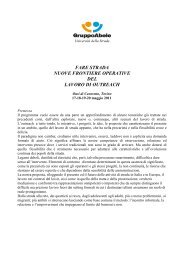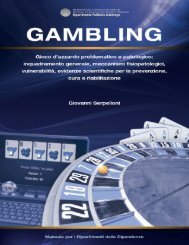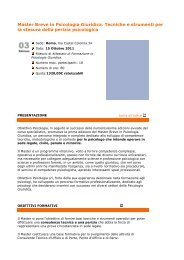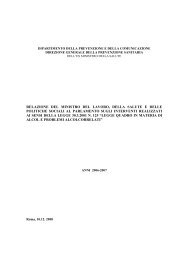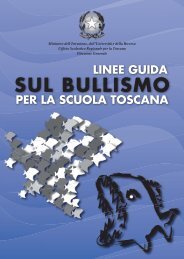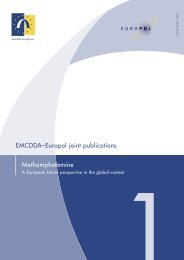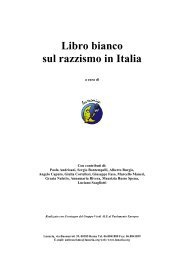Neuroscienze e dipendenze - Dipartimento per le politiche antidroga
Neuroscienze e dipendenze - Dipartimento per le politiche antidroga
Neuroscienze e dipendenze - Dipartimento per le politiche antidroga
You also want an ePaper? Increase the reach of your titles
YUMPU automatically turns print PDFs into web optimized ePapers that Google loves.
276 - E<strong>le</strong>menti di NEUROSCIENZE E DIPENDENZE<br />
ABSTRACT<br />
THE ADDICTED SYNAPSE: MECHANISMS<br />
OF SYNAPTIC AND STRUCTURAL PLASTICITY<br />
IN NUCLEUS ACCUMBENS<br />
Scott J Russo<br />
School and University Center of CUNY<br />
Department of Neuroscience Mount Sinai<br />
School of Medicine - New York, NY<br />
Drug addiction is marked long-lasting changes in behavior<br />
that result from altered patterns of gene expression<br />
within limbic forebrain regions, such as the nuc<strong>le</strong>us accumbens<br />
(NAc). These changes in gene transcription are<br />
coordinated by a comp<strong>le</strong>x series of histone modifications<br />
surrounding DNA that result in either repression or activation<br />
of gene expression. Recent evidence has identified<br />
a network of gene expression regulated by the transcription<br />
factor FosB, which alters the structure and<br />
function of NAc medium spiny neurons to control addiction-like<br />
behavior. This talk will include a discussion<br />
on recent advances in our understanding of chromatin<br />
regulation by cocaine, as well as the consequences on<br />
structural plasticity and its functional re<strong>le</strong>vance in driving<br />
addiction-related behavior.<br />
COMPULSIVE DRUG-SEEKING VERSUS<br />
HEDONIC BEHAVIOR MOTIVATED<br />
BY NATURAL REWARD: NEUROBEHAVIORAL<br />
MECHANISMS AND NOVEL ADDICTION<br />
TREATMENT TARGETS<br />
Friedbert Weiss<br />
Mo<strong>le</strong>cular and Integrative Neurosciences Department<br />
The Scripps Research Institute (TSRI) - La Jolla, CA<br />
Drug addiction is a chronically relapsing disorder characterized<br />
by compulsive drug seeking and use. A major<br />
factor contributing to the chronically relapsing and compulsive<br />
nature of addiction is the process of associative<br />
<strong>le</strong>arning whereby environmental stimuli repeatedly<br />
paired with drug consumption acquire incentive-motivational<br />
value, evoking expectation of drug availability<br />
and memories of past drug euphoria. Conditioned responses<br />
to such stimuli can activate brain reward mechanisms<br />
and have been implicated both in maintaining<br />
ongoing drug use and eliciting drug desire during abstinence,<br />
precipitating relapse. Cue-induced drug seeking<br />
in animals resemb<strong>le</strong>s along several dimensions the compulsive<br />
character of addiction in humans.<br />
This presentation will focus on chronic vulnerability<br />
to relapse – a pivotal aspect of the addiction process –<br />
with emphasis on neural substrates responsib<strong>le</strong> for the<br />
distinctly compulsive nature of drug-seeking that contrasts<br />
with normal behavior elicited by stimuli conditioned<br />
to natural rewards that is essential for survival,<br />
adaptive behavioral functioning and “healthy” hedonic<br />
pursuits. At the phenomenological <strong>le</strong>vel, evidence will be<br />
presented showing that the motivating effects of drugcues,<br />
as measured by conditioned reinstatement of reward<br />
seeking, are abnormally resistant to extinction,<br />
whereas the effects of stimuli conditioned to potent natural<br />
reward extinguish rapidly. Second, reinstatement by<br />
drug cues <strong>per</strong>sists over months of abstinence. Even stimuli<br />
present during a sing<strong>le</strong> lifetime cocaine ex<strong>per</strong>ience<br />
elicit drug seeking for up to one year, an effect not seen<br />
with stimuli conditioned to natural reward.<br />
Understanding of the mechanisms that differentiate<br />
compulsive drug seeking from normal goal-directed behavior<br />
has critical implications for understanding the<br />
neurobiological basis of maladaptive incentive motivation<br />
<strong>le</strong>ading to compulsive drug-seeking and the identification<br />
of effective treatment targets for craving and relapse<br />
prevention. At the mechanistic <strong>le</strong>vel, therefore, data<br />
will be presented that (1) implicate the hypothalamic<br />
orexin/hypocretin system as preferentially mediating<br />
drug vs. normal reward-seeking, (2) implicate<br />
metabotropic mGlu2/3 and mGlu5 receptors in conditioned<br />
drug-seeking, but with a distinctly more se<strong>le</strong>ctive<br />
ro<strong>le</strong> of mGlu2/3 receptors in reinstatement by environmental<br />
stimuli conditioned to drugs vs. natural reward.<br />
However, (3) both receptors adapt with chronic cocaine<br />
and alcohol exposure such that the efficacy of pharmacological<br />
mGlu2/3 manipulation to interfere with drug<br />
seeking increases (associated with enhanced G-protein<br />
coupling), whereas manipulations of the mGlu5 receptor<br />
loose their efficacy. (4) An additional target with a se<strong>le</strong>ctive<br />
mediation of drug seeking that emerged in these<br />
studies is the 1 receptor. (5) Lastly, it is possib<strong>le</strong> that<br />
neuroadaptation associated with histories of previous<br />
drug use prevents “un<strong>le</strong>arning” of maladaptive, or <strong>le</strong>arning<br />
of new adaptive behavior, and thereby conveys “compulsive”<br />
character to behavior motivated by other stimuli<br />
including cues conditioned to natural reward. Consistent<br />
with this hypothesis, our data reveal that rats with<br />
a previous cocaine history show greater resistance to extinction<br />
of responding for cues associated with potent<br />
natural reward. More importantly, these rats showed <strong>per</strong>sistent<br />
reinstatement induced by cues conditioned to potent<br />
natural reward over repeated reinstatement tests, resembling<br />
that seen in “conventional” tests of drug-seeking,<br />
thus revealing a “switch” toward compulsive-like<br />
behavior associated with stimuli conditioned to natural<br />
reinforcers in previously drug-dependent rats. Overall<br />
the results advance current understanding of mechanisms<br />
regulating behavior directed at obtaining drugs of<br />
abuse vs. natural reinforcers. (Supported by DA07348,<br />
DA08467 AA018010, AA10531).



